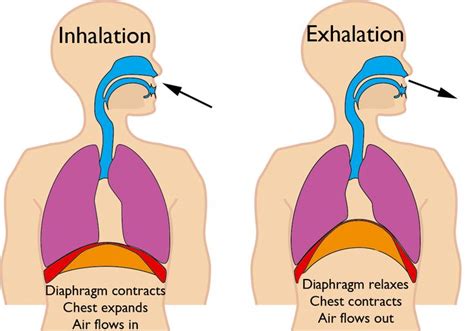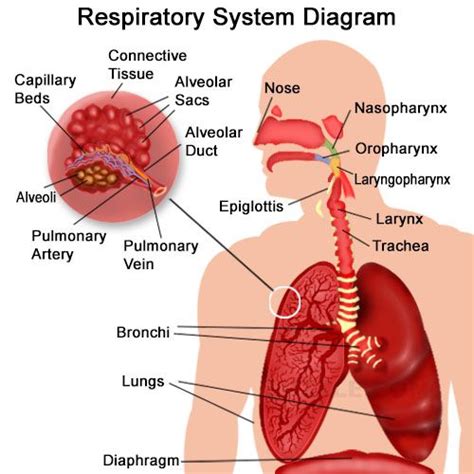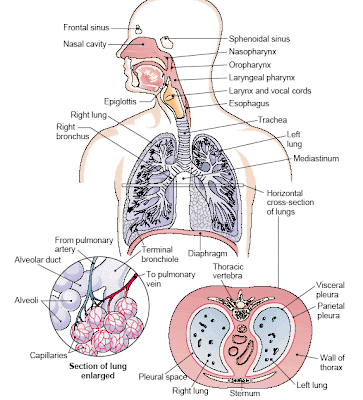Healing Breath: How to Use the Power of Breathing to Heal, Reduce Stress and Improve Wellbeing.
Click here.
Beginning to breathe
To begin to breathe effectively again means remembering what we only seem to have lost -- our connection with the Source. Our relationship with our breathing can be seen as a statement about our relationship with the Source and our higher self, or who we really are. we know that, whereas earlier cultures and specific traditions have maintained a knowledge and practice of relating .... (Click here to continue ) We can change the bad habit of inefficient breathing by short, but regular, sessions of conscious breathing.
BREATHING IN; INHALATION: life force + oxygen-laden air, expanding lungs, lowered diaphragm.

BREATHING OUT; EXHALATION: waste gases + carbon dioxide + life force, contracting lungs, raised diaphragm.
The Breathing Process
The process of breathing begins with the movement of the diaphragm, the large muscle at he base of the ribcage that forms the floor of the chest. each breath is initiated by a signal from the respiration centre of the brain to flatten the diaphragm downwards. the cavity enclosed by the ribcage is enlarged, thus creating a vacuum effect in the space. The lungs are suspended in this cavity and immediately expand to fill the space, drawing in air via the nose or mouth. The diaphragm then relaxes upwards, which deflates the lungs, forcing the breath to be expelled.
When we breathe normally, we inhale air through the nose. the nose is divided into two narrow cavities by a partition, the septum, which is made of bone and cartilage. the nostrils are lined with fine hairs that can filter out dust and other foreign particles from the air. If too many particles accumulate, the sneezing spasm is triggered. The mucous membrane in the nasal cavity moistens and warms the air as it is breathed in. Our body needs warms fresh air, not cool/cold stale air. The air then passes over the back of the mouth, down past the larynx (voice-box), into the trachea (windpipe), when it then branches into the left and right lungs.


The lungs are like bags that are lined with a fine membrane containing millions of air sacs (the alveoli), which contain blood vessels with walls so thin that oxygen and carbon dioxide can easily pass into and out of the blood. it is amazing to think that if the lungs with all their alveoli were completely flattened out, they would cover an area of about 75 square metres.
Essentially, there are two breaths: the in-breath and the out-breath, inhalation and exhalation, which you feel as different sensations. As air is taken into the lungs, oxygen passes through their fine membranes and into the bloodstream to oxygenate the cells and tissues of all the organs in the human body, especially the brain. Every cell in the body needs oxygen to carry out its functions and to release energy from its chemical activities. As you exhale, waste gases, such as carbon dioxide, from the body processes are conveyed to the lungs. Via the fine membranes of the lungs, waste products can be expelled from the bloodstream and released with the out-breath. All this happens in a few seconds, creating one of the human body's great rhythmic movements. footnote to this basic process: breathing is not something happening to you alone. Life finds good use for what we may consider to be waste products. the whole plant world takes in carbon dioxide from the air and, through its life processes, expels oxygen, which is then available to animal life. this is the beautiful picture of our inter-dependence. The time you breathe consciously, consider where the oxygen you so vitally need might have come from and where the carbon dioxide you are giving away might be going. Life sustaining life, an ongoing process.
Nasal breathing versus mouth breathing.
Breathing through the nose is the ideal way to breathe because ...
(Click here to continue) .... lumbar region of the spine. This 'corset' actually exists within our own bodies in the form of the abdominal muscle - the transverse abdominals at a deep level, combined with the upper layer of the internal oblique muscle. these two sets of muscles together make up a physical girdle extending from the ribcage to the lower abdomen.
EXERCISE 3
Breathing to support your back (click here to read more)
Click here.
Beginning to breathe
To begin to breathe effectively again means remembering what we only seem to have lost -- our connection with the Source. Our relationship with our breathing can be seen as a statement about our relationship with the Source and our higher self, or who we really are. we know that, whereas earlier cultures and specific traditions have maintained a knowledge and practice of relating .... (Click here to continue ) We can change the bad habit of inefficient breathing by short, but regular, sessions of conscious breathing.
BREATHING IN; INHALATION: life force + oxygen-laden air, expanding lungs, lowered diaphragm.
BREATHING OUT; EXHALATION: waste gases + carbon dioxide + life force, contracting lungs, raised diaphragm.
The Breathing Process
The process of breathing begins with the movement of the diaphragm, the large muscle at he base of the ribcage that forms the floor of the chest. each breath is initiated by a signal from the respiration centre of the brain to flatten the diaphragm downwards. the cavity enclosed by the ribcage is enlarged, thus creating a vacuum effect in the space. The lungs are suspended in this cavity and immediately expand to fill the space, drawing in air via the nose or mouth. The diaphragm then relaxes upwards, which deflates the lungs, forcing the breath to be expelled.
When we breathe normally, we inhale air through the nose. the nose is divided into two narrow cavities by a partition, the septum, which is made of bone and cartilage. the nostrils are lined with fine hairs that can filter out dust and other foreign particles from the air. If too many particles accumulate, the sneezing spasm is triggered. The mucous membrane in the nasal cavity moistens and warms the air as it is breathed in. Our body needs warms fresh air, not cool/cold stale air. The air then passes over the back of the mouth, down past the larynx (voice-box), into the trachea (windpipe), when it then branches into the left and right lungs.

The lungs are like bags that are lined with a fine membrane containing millions of air sacs (the alveoli), which contain blood vessels with walls so thin that oxygen and carbon dioxide can easily pass into and out of the blood. it is amazing to think that if the lungs with all their alveoli were completely flattened out, they would cover an area of about 75 square metres.
Essentially, there are two breaths: the in-breath and the out-breath, inhalation and exhalation, which you feel as different sensations. As air is taken into the lungs, oxygen passes through their fine membranes and into the bloodstream to oxygenate the cells and tissues of all the organs in the human body, especially the brain. Every cell in the body needs oxygen to carry out its functions and to release energy from its chemical activities. As you exhale, waste gases, such as carbon dioxide, from the body processes are conveyed to the lungs. Via the fine membranes of the lungs, waste products can be expelled from the bloodstream and released with the out-breath. All this happens in a few seconds, creating one of the human body's great rhythmic movements. footnote to this basic process: breathing is not something happening to you alone. Life finds good use for what we may consider to be waste products. the whole plant world takes in carbon dioxide from the air and, through its life processes, expels oxygen, which is then available to animal life. this is the beautiful picture of our inter-dependence. The time you breathe consciously, consider where the oxygen you so vitally need might have come from and where the carbon dioxide you are giving away might be going. Life sustaining life, an ongoing process.
Nasal breathing versus mouth breathing.
Breathing through the nose is the ideal way to breathe because ...
(Click here to continue) .... lumbar region of the spine. This 'corset' actually exists within our own bodies in the form of the abdominal muscle - the transverse abdominals at a deep level, combined with the upper layer of the internal oblique muscle. these two sets of muscles together make up a physical girdle extending from the ribcage to the lower abdomen.
EXERCISE 3
Breathing to support your back (click here to read more)

No comments:
Post a Comment